By Ebony L. McCline
ChicagoTalks first published a story about the Springfield race riots on Feb. 27, 2008. With the opening this month of the “Summer of Hate: A Modern Perspective of the Springfield Race Riot of 1908” exhibit at the Bronzeville Visitor Information Center, we’re highlighting again this important historical issue. The special traveling exhibit runs through July 31.
Illinois has awarded a $300,000 grant for a sculpture that would commemorate the launch of the NAACP and mark the 100-year anniversary of the 1908 Springfield race riots.
The Capital Development Board, which is in charge of state construction projects, awarded the grant Feb. 5. The sculpture, which is considered a construction project, will be created under the Art in Architecture program.
Since the program began in 1977, more than 600 works of art have been acquired or custom-built.
“The monument is $250,000,” said Kenneth Page, president of the Springfield NAACP. “We’re gonna make everything fit into budget.”
The remaining $50,000 is for the base of the sculpture and the preparation of the land, Page said.
The sculpture will be in Union Square Park near the Abraham Lincoln Presidential Library and the Abraham Lincoln Presidential Museum, which would be a continuous reminder of race relations, said Dave Blanchette, spokesperson for the Capital Development Board.
The traffic from the museum makes it a good location, he said.
“We knew there would be people from all over the world coming to visit that museum,” said Page. “I knew it had to be in a place where people would see it.”
Some people in Springfield didn’t want the sculpture built, Page said. The Springfield NAACP therefore took the initiative to Gov. Rod Blagojevich and explained its significance.
The 1908 Springfield race riot started on Aug. 14 after a white mob attacked black residents and business owners. By the end of the two-day riot, four whites and two blacks had died.
Page said he knew that artist Preston Jackson was perfect for this project. Jackson, 63, has been a professor of sculpture at the School of the Art Institute of Chicago since 1989.
“If someone should do this monument,” said Page, “it should be someone close to the soil in that area.”
Blanchette agreed- Jackson was the only artist contacted for the job.
“The state of Illinois and the city of Springfield felt that he would best do just to the sculpture,” Blanchette said.
The sculpture is Jackson’s way of constructing history out of bronze and steel, he said. He has started sketches, but has not finalized any designs.
“This way people can’t help but to question what it’s about,” he said, adding that young people must know this history as well.
After destroying an all-black neighborhood, the mob lynched a black barber. White residents were angry because the city jail secretly released two suspects: one who reportedly sexually assaulted a white woman and the other who was accused of killing a white railroad engineer. The suspects were secretly released because of fear of their safety.
As a direct result of these actions, a group of civil rights activist began to have meetings that later led to the formation of the nationwide NAACP.
Both the Capital Development Board and the Springfield NAACP said the sculpture should be completed by fall. Page hopes to unveil the sculpture at the Illinois State NAACP Convention in October.
“The race riot isn’t something we want to hide,” said Blanchette. “We’re noting how far we have come from 100 years ago.”
Bronzeville Visitor Information Center
Presents Summer of Hate
Traveling Exhibit
July 1 – 31, 2008
“Summer of Hate: A Modern Perspective of the Springfield Race Riot of 1908”
summer of hate
The Springfield Race Riots broke out in 1908 when, within hours of a reported rape on a white woman by a black man , hundreds took to the street in fierce mob action against African-Americans. Though the woman eventually confessed to lying about the incident, the African-American caretaker was jailed and awaited trial by an all-white jury. The violence held sway in the city for several days and resulted in the deaths of two black businessmen and four white men.
Businesses owned by African-Americans and Jews were destroyed, houses were burned and hundreds were injured before 4000 state militiamen intervened. Illinois is the home of President Abraham Lincoln, the most celebrated president in the world, a place where Black citizens would certainly be safe to live and prosper. Imagine the shock waves throughout this country one hundred years ago when rioting against Black citizens broke out in Springfield. Yet this tragic event served as a rallying cause in founding the National Association for the Advancement of Colored People (NAACP).
The exhibit entitled “Summer of Hate: Modern Perspective of the Springfield Race Riot of 1908,” which included fourteen banners created by the 2007 Summer Scholars of the Abraham Lincoln Presidential Library and Museum. The children have done an outstanding job creatively expressing the issues of racial tolerance using the Springfield Race Riots of 1908 as a reference. Through their eyes, we relive the painful experience of racial violence that undermined law and order, and disrupted the lives of many. The impact of prejudice serves as a reminder that we must not repeat the mistakes of nearly a century ago and that we should continue to work on accepting our differences. We are proud to display the work of talented and socially-aware children that capture the racial injustice of that time.
Major Exhibit At Abraham Lincoln Presidential Museum & Library
Race Riot ImageSomething So Horrible: Springfield Race Riot of 1908 will illustrate how racism and political corruption undermined law and order and set the stage for mob rule. The exhibit will also show how an event of one hundred years ago lives in both the historical record of the past and the racial divisions that continue to confound us.
Something So Horrible Exhibit Programs – Springfield, IL
Springfield Walks
Springfield’s 1908 Race Riot Walk
June 7, 14, 21, 28, July 5, 12, 19, 26, August 2, 9, 16, 23, and 30. The 16th will be a special anniversary tour (This tour involves mature subject matter.)
For Reservations: Tinsley Dry Goods – 217.525.1825 orGarret Moffett – 309.221.5579
Springfield Race Riot Walking Tour
Getting To Springfield amtrak
The Abraham Lincoln Presidential Library & Museum is centrally located in downtown Springfield, Illinois and is easily accessible via car, rail (Amtrak), or air (Springfield’s Abraham Lincoln Capital Airport). Once in Springfield getting around is quick and easy using local taxi service or public transit. There is also a sight-seeing trolley. Driving distances from Chicago 175 Miles
Specal Thanks to the Abraham Lincoln Presidential Library & Museum Education Department
Alplm logo
Bronzeville Visitor Information Center
411 East 35th Street
Chicago, IL 60653
Hours: Monday – Friday: Noon to 5 PM
Saturday: 11 AM to PM
Closed Sunday
Admission $5.00 Adults/ $3.00 Students & Seniors
Call 773.373.2842 for Group Tours
Current Exhibits:
Provident Foundation: ‘Medical Miracles Traveling Exhibit’
Bronzeville to Harlem by Preston Jackson

![Reblog this post [with Zemanta]](http://img.zemanta.com/reblog_e.png?x-id=fc8cc76a-c200-48d4-87e2-1ebdcb630c98)




Be First to Comment